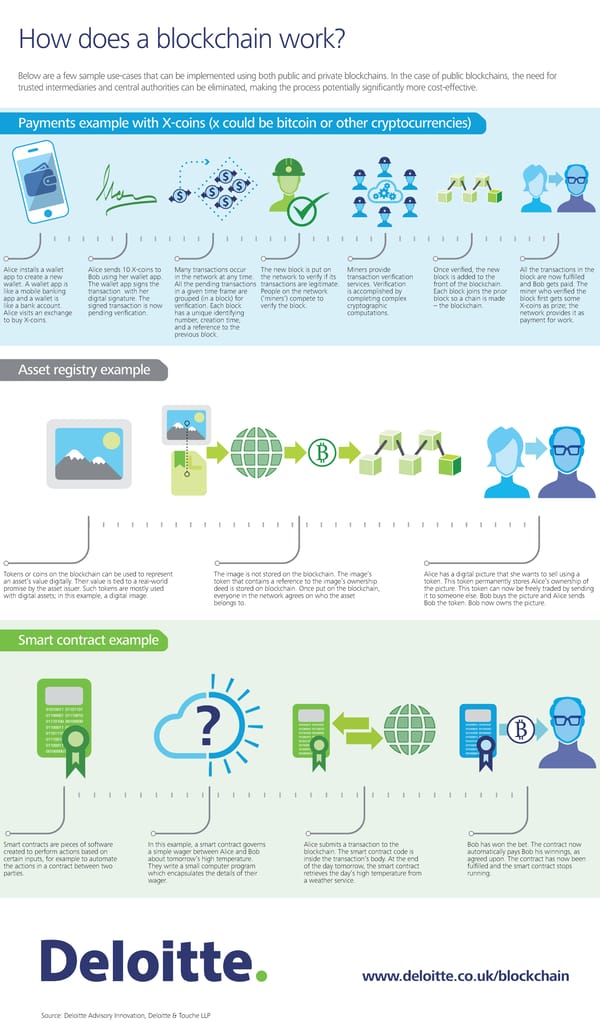How does a blockchain work?
How does a blockchain work? Below are a few sample use-cases that can be implemented using both public and private blockchains. In the case of public blockchains, the need for trusted intermediaries and central authorities can be eliminated, making the process potentially significantly more cost-effective. Payments example with X-coins (x could be bitcoin or other cryptocurrencies) Alice installs a wallet Alice sends 10 X-coins to Many transactions occur The new block is put on Miners provide Once verified, the new All the transactions in the app to create a new Bob using her wallet app. in the network at any time. the network to verify if its transaction verification block is added to the block are now fulfilled wallet. A wallet app is The wallet app signs the All the pending transactions transactions are legitimate. services. Verification front of the blockchain. and Bob gets paid. The like a mobile banking transaction with her in a given time frame are People on the network is accomplished by Each block joins the prior miner who verified the app and a wallet is digital signature. The grouped (in a block) for (’miners’) compete to completing complex block so a chain is made block first gets some like a bank account. signed transaction is now verification. Each block verify the block. cryptographic – the blockchain. X-coins as prize; the Alice visits an exchange pending verification. has a unique identifying computations. network provides it as to buy X-coins. number, creation time, payment for work. and a reference to the previous block. Asset registry example Tokens or coins on the blockchain can be used to represent The image is not stored on the blockchain. The image’s Alice has a digital picture that she wants to sell using a an asset’s value digitally. Their value is tied to a real-world token that contains a reference to the image’s ownership token. This token permanently stores Alice’s ownership of promise by the asset issuer. Such tokens are mostly used deed is stored on blockchain. Once put on the blockchain, the picture. This token can now be freely traded by sending with digital assets; in this example, a digital image. everyone in the network agrees on who the asset it to someone else. Bob buys the picture and Alice sends belongs to. Bob the token. Bob now owns the picture. Smart contract example 01010011 01101101 01100001 01110010 01110100 00100000 01100011 01101111 01010011 01101101 01010011 01101101 01100001 01110010 01100001 01110010 01101110 01110100 01110100 00100000 01110100 00100000 01110010 01100001 01100011 01101111 01100011 01101111 ? 01101110 01110100 01101110 01110100 01100011 01110100 01110010 01100001 01110010 01100001 00100000 01100101 01100011 01110100 01100011 01110100 00100000 01100101 00100000 01100101 Smart contracts are pieces of software In this example, a smart contract governs Alice submits a transaction to the Bob has won the bet. The contract now created to perform actions based on a simple wager between Alice and Bob blockchain. The smart contract code is automatically pays Bob his winnings, as certain inputs, for example to automate about tomorrow’s high temperature. inside the transaction’s body. At the end agreed upon. The contract has now been the actions in a contract between two They write a small computer program of the day tomorrow, the smart contract fulfilled and the smart contract stops parties. which encapsulates the details of their retrieves the day’s high temperature from running. wager. a weather service. www.deloitte.co.uk/blockchain Source: Deloitte Advisory Innovation, Deloitte & Touche LLP

